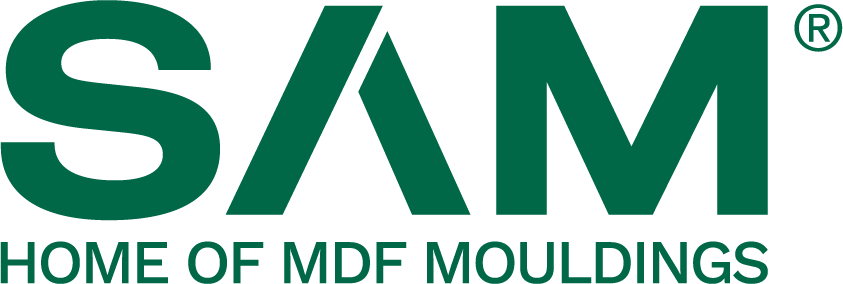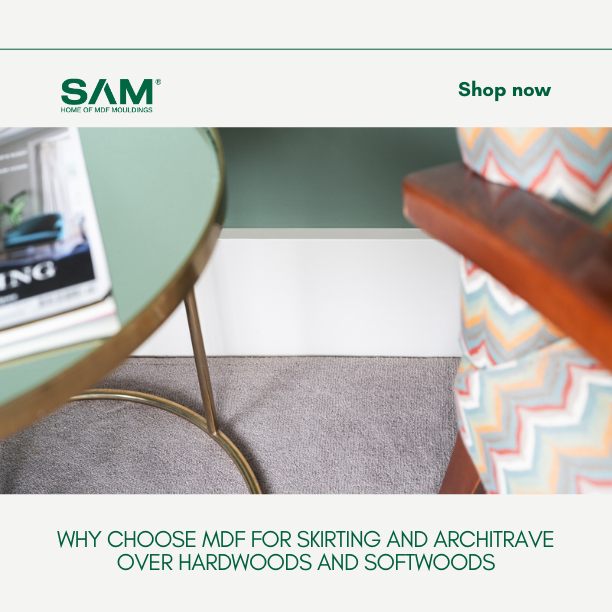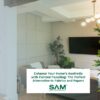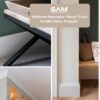When it comes to choosing materials for skirting and architrave, homeowners and professionals alike face the dilemma of picking between MDF, softwood, and hardwood. Each material has its own unique properties and benefits, but MDF stands out as the superior choice for several compelling reasons. Here at SAM, we believe in delivering quality and value, so we’ve explained why MDF for Skirting and Architrave Over Hardwoods and Softwoods is the best option for your next project.
1. Dimensional Stability and Consistency
MDF: One of the most significant advantages of MDF is its dimensional stability. MDF is engineered by breaking down hardwood and softwood residuals into wood fibers, combining them with wax and resin, and forming panels under high temperature and pressure. This process ensures a consistent density and uniformity, making MDF highly stable and resistant to warping, cracking, and swelling.
Softwood and Hardwood: In contrast, natural wood, whether softwood or hardwood, can be unpredictable. Natural wood expands and contracts with changes in humidity and temperature, leading to potential warping and splitting over time. Variations in grain patterns and density can also affect the consistency of the finish.
2. Smooth Finish and Paintability
MDF: MDF provides an exceptionally smooth surface that is ideal for painting. Its uniform texture ensures that paint adheres well, resulting in a flawless finish. MDF skirting and architrave can be painted in any colour to match your interior design, offering versatility and aesthetic appeal.
Softwood and Hardwood: While softwood and hardwood can also be painted, they often require more preparation. Natural wood has grain patterns and knots that can show through the paint, necessitating additional sanding and priming to achieve a smooth finish. Moreover, the paint may not adhere as evenly due to the varying densities within the wood.
3. Cost-Effectiveness
MDF: Cost is a crucial factor in any home improvement project. MDF is generally more affordable than both softwood and hardwood. Its lower cost does not compromise its quality or durability, making it an economical choice for skirting and architrave.
Softwood and Hardwood: Natural wood, especially hardwood, can be quite expensive. The cost of sourcing, treating, and finishing natural wood often makes it a less budget-friendly option. For projects requiring extensive moulding, the cost difference can be substantial.
4. Ease of Installation
MDF: MDF is easier to work with compared to natural wood. It can be cut, shaped, and installed with standard woodworking tools without the risk of splintering or chipping. Its uniform density allows for clean cuts and precise detailing, which simplifies the installation process.
Softwood and Hardwood: Installing natural wood can be more challenging. The grain and density variations in softwood and hardwood can make cutting and shaping more difficult, increasing the likelihood of splintering or cracking. This can lead to additional time and effort during installation.
5. Environmental Considerations
MDF: MDF is often made from recycled wood fibres and residues, making it a more environmentally friendly option. By utilising wood waste that would otherwise be discarded, MDF helps in reducing overall waste and promoting sustainable practices in the woodworking industry.
Softwood and Hardwood: The production of natural wood products involves the harvesting of trees, which can have a significant environmental impact if not managed sustainably. While there are sustainable forestry practices, the use of virgin wood resources still raises concerns about deforestation and habitat destruction.
6. Customisation and Design Flexibility
MDF: The manufacturing process of MDF allows for a high degree of customisation. MDF can be easily moulded into intricate designs and profiles, providing a wide range of options for skirting and architrave styles. This flexibility enables homeowners to achieve the exact look they desire, whether it’s a classic, modern, or bespoke design.
Softwood and Hardwood: While natural wood can also be customised, it is generally more challenging to achieve intricate designs due to the limitations imposed by the wood’s grain and density. Additionally, the customisation of natural wood often requires more skilled labour and specialised tools.
7. Durability and Longevity
MDF: MDF’s engineered composition makes it highly durable and resistant to common issues such as splitting, cracking, and warping. When properly installed and maintained, MDF skirting and architrave can last for many years, maintaining their appearance and structural integrity.
Softwood and Hardwood: While hardwood is known for its durability, it is still susceptible to environmental factors that can lead to wear and tear over time. Softwood, being less dense, is more prone to damage from impacts and environmental changes. Both types of natural wood require more maintenance to ensure their longevity.
SAM – Home of MDF Mouldings
MDF emerges as the superior choice for skirting and architrave due to its dimensional stability, smooth finish, cost-effectiveness, ease of installation, environmental benefits, customisation options, and durability. At SAM, we are committed to providing high-quality MDF products that meet the diverse needs of our customers. Whether you are renovating your home or working on a new build, MDF skirting, and architrave offers a practical, aesthetic, and sustainable solution that outperforms both softwood and hardwood.
Choose MDF mouldings from SAM and experience the perfect blend of quality, value, and performance for your home improvement projects.



